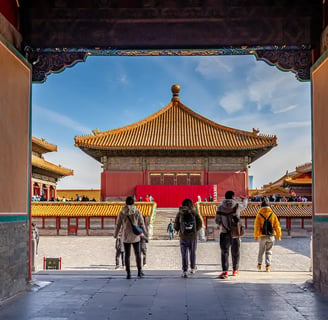Forbidden City China: Secrets of the Imperial Palace Unveiled
Explore the Forbidden City China, a magnificent imperial palace filled with rich history, culture, and architecture— home to Chinese emperors for centuries.
Marium


When you step into Beijing, you'll be transported back to a world where emperors ruled, dynasties flourished, and power was symbolized in grand, breathtaking structures. This place? The Forbidden City China—or, as it’s officially known today, the Palace Museum. In addition to being a historical monument, it also symbolizes imperial power, culture, and architecture of the ancient country.
What Makes the Forbidden City So Special?
The Forbidden City isn’t just a collection of ancient buildings; it’s a living testament to centuries of history, covering the rule of 24 emperors across two powerful dynasties—the Ming Dynasty and the Qing Dynasty. Built by Emperor Zhu Di in 1420, during the reign of the Yongle Emperor, this sprawling palace complex served as the political and ceremonial center of Chinese life for over 500 years.
But what’s truly fascinating is the imperial palace’s size and layout. Imagine a world where everything—from the colors to the architecture to the positioning of each structure—was designed to represent cosmic harmony and imperial authority. Every inch of this vast complex is imbued with symbolic meaning. It’s not just a palace; it’s a symbol of supreme power.
The Magnificent Architecture: A Reflection of Imperial Power
When you first look at the Meridian Gate, the main gate of the Forbidden City, it’s impossible not to feel awestruck. This monumental entrance marks the start of the central axis, a carefully designed line running through the entire palace complex, representing the connection between Earth and Heaven. For the Chinese emperors, the central axis wasn’t just a way to organize space—it was a reminder that their rule, too, was part of a tremendous cosmic order.
As you wander the outer court, you’ll encounter the grand Hall of Supreme Harmony, where major state affairs were conducted and Kings addressed their ministers and officials. This hall's sheer size and beauty are meant to convey the Chinese emperors’ absolute power over the state and the people. It's easy to imagine the courtly rituals and royal decisions that once took place here.
The Inner Court: Life Behind the Scenes
But let’s not forget the inner court. While the outer court represented the emperor’s authority over the realm, the inner court was the residence of the imperial family. Here, Rulers held private audiences with high-ranking officials or attended to matters of mental cultivation and personal reflection. In these rooms, monarchs prepared for the heavy responsibility of ruling a vast empire.
Some rooms served as private living spaces for the imperial consort and empress dowager, who wielded considerable influence. The Palace Museum holds countless artifacts that paint a picture of the daily lives of those who inhabited these chambers, from royal rituals to personal treasures.
A Glimpse into Emperors' Lives and Their Courts
Walking through the Forbidden City in China, you can’t help but imagine the intrigue, the grandeur, and the imperial court drama that must have unfolded within these walls. Did you know that the palace complex contained over 9,000 rooms? From the Eastern palaces to the Western palaces, every inch was designed to reflect the hierarchy and power dynamics of the royal family.
The Empress Dowager Cixi, one of the most powerful women in Chinese history, had her share of influence here. Her presence in the Forbidden City changed the entire course of history during the late Qing dynasty. Cixi’s strategic mind and the ability to control the Overlord were as powerful as the grand halls themselves. The stories of these emperors and empresses are still preserved in the Palace Museum, where the most extensive collection of Chinese imperial artifacts can be found.
Preserving China’s Imperial Legacy:
Today, the Forbidden City stands as a UNESCO World Heritage Site, admired by millions of tourists and history buffs from all over the world. But beyond its magnificent architecture and historical significance, it’s also a symbol of China’s resilience and commitment to preserving its cultural heritage. The Palace Museum, with its thousands of years of history, is as much about remembering the past as it is about preserving it for the future.
Walking through the grand halls, past the corner towers, and into the Imperial Garden, you understand why the Forbidden City is often called the Imperial City. The beauty and grandeur of its design reflect the supreme power once held by the Monarch and the central role this place played in shaping ancient Chinese history.
A Connection Between the Past and the Present:
While the Forbidden City in China was the seat of power for centuries, its importance continues today. It serves as a reminder of the Celestial Empire’s rich cultural and historical legacy, one that has weathered dynasties, revolutions, and cultural transformations. It’s not just a monument to the past but a bridge between ancient China and the modern People’s Republic of China.
And, of course, we can’t forget Jingshan Park—just a stone’s throw from the Forbidden City. It offers one of the best views of this iconic Chinese architecture while being a peaceful reminder of the earthly tranquility that emperors sought in their private lives. The imperial city is a living, breathing part of original Chinese history, from the majestic Tiananmen Square to the ornate main halls.
Conclusion: A Journey Through Time
Visiting the Forbidden City in China isn’t just about seeing ancient buildings; it’s about stepping into the world of Chinese emperors, where every courtyard and hallway tells a story of power, luxury, and cultural sophistication. It’s a reminder of how history, architecture, and the quest for harmony shaped one of the most fascinating cultures the world has ever known. Whether you’re drawn in by the historical significance or the architectural artistry, the imperial palace is an unforgettable experience. It is a place where the past meets the present in a spectacular display of imperial might and ancient wisdom.
Explore
Discover
Luxury travel experiences and cultural adventures await you.
© 2024. All rights reserved.
